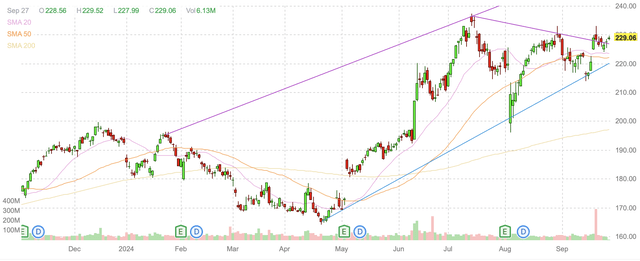Summary:
- Apple is poised for a strong Q4 2024 and beyond, driven by the iPhone 16 launch and potential new product introductions.
- Revenue growth is expected to be 7% in 2025 and 5-7% in 2026, or greater, with gross margins in the mid-40% range.
- Risks include potential product launch failures, extended hardware upgrade cycles, and regulatory scrutiny.
- Apple shares could reach $255 in 2025, with a forward P/E of 30, but any near-term appreciation above 20% may mark a top.
yalcinsonat1/iStock Editorial via Getty Images
Apple (NASDAQ:AAPL) looks primed to have a strong final quarter of 2024 on the strength of a successful launch to the iPhone 16. Apple’s sales appear likely to increase by at least seven percent in 2025, and five to seven percent in 2026. Apple’s revenue growth could be greater than this with the introduction of new products and/or services. For example, Apple may roll out additional features that work on their newest iPhone models that not only compel consumer upgrading in late 2024 and early 2025, but which also promote greater purchasing of Apple services.
Apple just released its iPhone 16 lineup in the U.S. earlier this September. Generative AI (“GenAI”) features are among the key additions to the device, though one can never discount the importance of Apple improving the iPhone’s camera. Apple calls its GenAI features Apple Intelligence, and their usage will require their new devices to operate. Apple Intelligence is available on all models of iPhone 16, as well as the iPhone 15 Pro and 15 Pro Max. Apple’s GenAI features will include the capability to rewrite emails, make summaries, and prioritize notifications, as well as multi-application actions. The iPhone 16 is being released at the same starting retail pricing as was the iPhone 15 back in 2023. While this pricing is not cheap, the lack of a price increase should help drive adoption and upgrading.
Another factor in Apple’s capacity to continue to grow revenue and earnings will be sales within China. Apple’s sales in china have declined over the last year, but this trend could reverse on this new iPhone cycle, as well as the newer M4 iPads. Even if these products are not wildly successful in China, the declines sustained over the last several quarters should present easier year-over-year comparisons for the company.
There is also the potential for Apple to find India to become a more meaningful driver of revenue. Beyond India growing more wealthy in the coming years, Apple has been investing in developing Indian manufacturing capacity, and this could make it more of a preference within the region that it would have otherwise been. Moreover, its growing employee base there are more likely than the average consumer to drive adoption of their products.
Apple is likely to have gross margins in the mid 40 percent range throughout the next several years. Last year, Apple had a margin of 44.1 percent margin, and it is likely to be slightly higher this year and potentially next year as well. A reason for the slight increase to Apple’s margins would be the growth of services, where Apple has some of its highest margins. For example, Apple’s services margin was over 74 percent last quarter.
Apple’s free cash flow is likely to be at or above $110 billion this year. If the company is capable of meeting the above-mentioned revenue and margin expectations, it is likely that Apple will also be able to grow its free cash flow in the high single digits in 2025 and 2026. I would also anticipate similar levels of Apple increasing share repurchasing plans in each of the next two years.
Apple trades at a premium valuation, but this is likely reasonable due to the position the company holds in most of its markets. This is because Apple maintains high margins on hardware sales, which is uncharacteristic for hardware, and the growing services business it is cultivating. Apple has become a brand that works as a status symbol and which may be seen in some regions as a luxury brand, and this status, as well as the quality of products Apple produces, helps the company maintain higher margins that generate impressive free cash flow.
As is often the case for luxury goods and brands that project status, Apple appears likely to be able to increase average selling prices annually. It is also likely that a growing user base will support growth within Apple’s services businesses, including cloud, gaming, and advertising services, as well as hardware upgrading as a subscription service.
Apple is also capable of replicating compelling products brought to market by competitors, such as foldable screens, wearable AI peripherals, and health care related devices. Apple’s capacity to introduce products that work seamlessly with their existing ones is appreciated by their existing customers, many of whom are willing to pay more for a high quality product that will require little to no learning curve.
Apple appears likely to gain in the holiday quarter on the strength of early adoption of the iPhone 16. Shares have been in a fairly tight trading range for the last few months, and appear to be blearing out to the upside, and that move is coinciding with the new model’s release. The release of positive early numbers and potential visibility of a successful Thanksgiving sales promotion could instigate a move to the top of its trading range. This could mean shares move up to between $240 and $260 per share.

Apple daily candlestick chart (Finviz.com)
My 2025 target for Apple is $255, based on a forward price to earnings multiple of 30 and expected 2026 earnings of $8.50 per share. Actual earnings growth could surpass this expectation on a strong upgrade cycle for iPhone 16, as well as continued services growth. Moreover, Apple’s capacity to repurchase shares is a factor that often helps the company increase earnings per share to a greater degree than is expected. While 30 is an above average multiple, I believe it is reasonable premium for Apple. Further, Apple’s current P/E ratio is between 34 and 35, which is significantly higher than 30. If Apple were to trade at a 34 multiple on $8.50 in EPS, that would equate to a $290 valuation. I believe such pricing is unlikely in the near term, but possible. If pricing in the high $200s were reached in the near term, that would likely be a short term top to be sold.
Risks
Apple’s primary risk is that a product launch is a failure, and that this calls to question the company’s position and customer loyalty to the brand. Such an issue would likely cause Apple to trade at a lower multiple, and also lower its revenue and margins.
Another risk to Apple is the extension of hardware upgrading cycles. If customers find their existing products sufficient to stave off replacing for another year or two, then this would lessen Apple’s sales trajectory. A major factor in this will be how GenAI services end up being delivered, and if they become largely available through existing hardware through cloud providers. It is currently anticipated that adding AI features to Apple’s iPhones will become a meaningful reason to instigate consumer upgrading, but such replacements are not certain.
Apple is also subject to regulatory scrutiny in the U.S. and other markets due to its dominance and high margins. This is most clearly evident within Apple’s services business, where changes may be forced upon the company.
Conclusion
Apple is likely to continue to perform reasonably well in the near and mid-term. The iPhone 16 is likely to have a successful launch throughout the holiday quarter, which should bode well for Apple shares in the near term. This new upgrade cycle could also promote growth in Apples services revenue on the back of GenAI features out of Apple Intelligence.
While Apple does seem to have the potential to appreciate in the near term, the company also appears close to fairly valued. I believe that any near term appreciation of greater than 20% from here is likely to mark a top in pricing that is likely to take a while for the company to surpass.
Analyst’s Disclosure: I/we have no stock, option or similar derivative position in any of the companies mentioned, but may initiate a beneficial Long position through a purchase of the stock, or the purchase of call options or similar derivatives in AAPL, over the next 72 hours. I wrote this article myself, and it expresses my own opinions. I am not receiving compensation for it (other than from Seeking Alpha). I have no business relationship with any company whose stock is mentioned in this article.
Seeking Alpha’s Disclosure: Past performance is no guarantee of future results. No recommendation or advice is being given as to whether any investment is suitable for a particular investor. Any views or opinions expressed above may not reflect those of Seeking Alpha as a whole. Seeking Alpha is not a licensed securities dealer, broker or US investment adviser or investment bank. Our analysts are third party authors that include both professional investors and individual investors who may not be licensed or certified by any institute or regulatory body.
